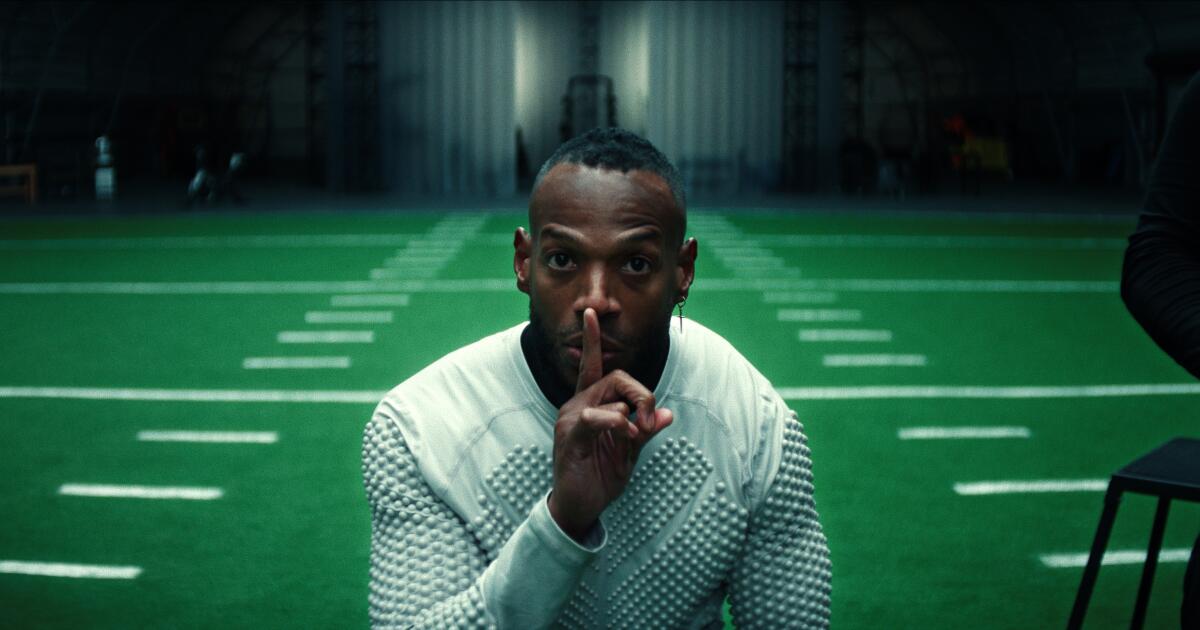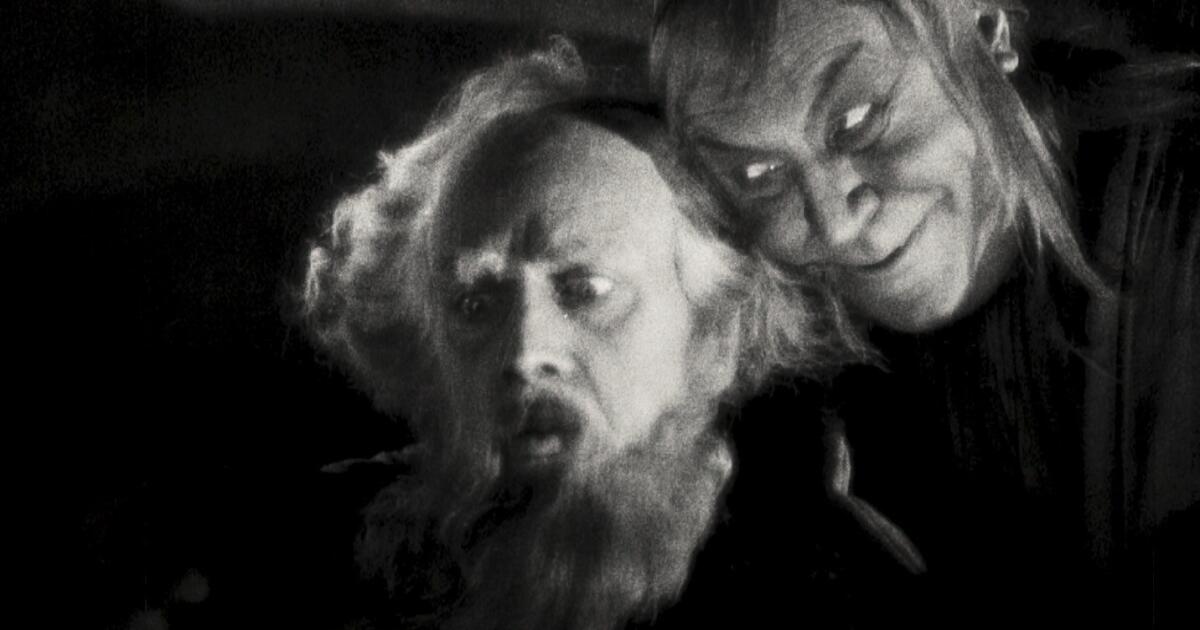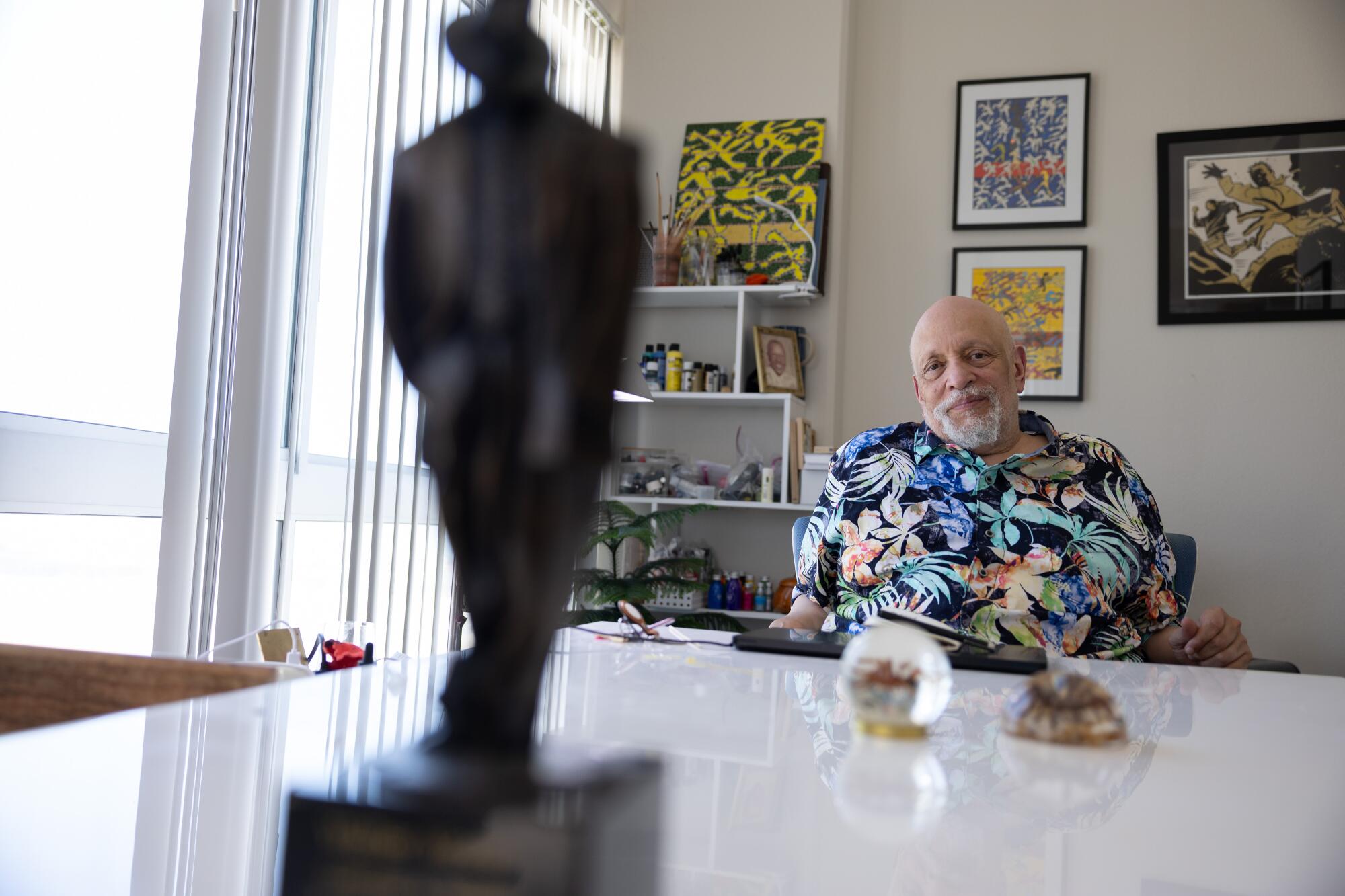‘Him’ review: Marlon Wayans plays a satanic GOAT quarterback
“Is football a game or a religion?” the sports broadcaster Howard Cosell once asked with exasperation. The horror film “Him,” a striking but vacuous gridiron Grand Guignol by Justin Tipping (“Kicks”) takes it as faith that the answer is both. Any fan with a sacred good luck ritual and any player who’s thanked the man upstairs for a touchdown knows the two overlap as tightly as a freshly laced pigskin.
In the home of young elementary schooler Cameron Cade (Austin Pulliam), the fictional San Antonio Saviors quarterback Isaiah White (Marlon Wayans) is the messiah. Next to the TV, there’s even a shrine with devotional portraits of their icon. When White wins a game while suffering a nasty injury, Cameron’s father seizes the moment to deliver a sermon: “That’s what real men do,” he insists. “They make sacrifices.” The candles on the altar flicker ominously.
Tipping, working from a Blacklist script by Skip Bronkie and Zack Akers with Jordan Peele as his producer, considers the sports-as-religion idea so obvious that the film doesn’t bother analyzing why it exists. Instead, “Him” wonders what kind of spiritual practice it is: hero worship or a sinister cult?
Fourteen years later, Cameron (now played by Tyriq Withers) has grown up to become a star college quarterback in line to be the NFL’s top draft pick and take over Isaiah’s position on the Saviors. A violent concussion knocks him off course, but Isaiah, a living legend still leading the team, offers to vouch for the kid if he passes a private training camp at his intimidating desert estate. It couldn’t be more obvious that Isaiah doesn’t have Cameron’s best interests at heart if he blared a warning on the Jumbotron.
The film’s title comes from a bit of braggadocio — “I’m him” — that started sprouting up in sports leagues during the last five years. (It’s why you’ll sometimes see Lakers shooting guard Austin Reaves called “AustHIM” Reaves.) Anointing someone the GOAT, as in “Greatest of All Time,” has been around longer, but the silly thing about both compliments is they’re getting handed out like Halloween candy. Whether Cameron can become the next GOAT is the movie’s main obsession. Yet it resonates, albeit vague and unexplored, with biblical references to goat offerings and images of Jesus as a sacrificial lamb and the movie’s visual allusions to the goat-headed occult idol Baphomet. Plus, it offers us in the audience the thrill of wondering if someone will get spit-roasted.
Cameron enters Isaiah’s home to discover his host surrounded by what looks like taxidermy sheep skins. Nearly all of the film takes place in his compound, a circular warren that looks like a combination of an ancient temple and the Superdome. We’re continually happy to discover all the menacing delights that production designer Jordan Ferrer has concocted. Inside, there’s unnerving minimalist furniture, dramatic saunas and ice baths and an indoor football field with a throwing machine powerful enough to knock out a tooth. Even more terrifying, there’s Isaiah’s lifestyle-influencer wife, Elsie (Julia Fox), who stomps around with a pointy shard of jade that Cameron is supposed to stick up his rear. (You know, for peak performance.) Meanwhile, outside the gates, Isaiah’s cult followers — like visibly brain-fried Marjorie (Naomi Grossman) — are furious that their champion may retire.
Like “Kicks,” Tipping’s excellent 2016 feature debut about a kid who risks his neck for a pair of Nikes, “Him” is about the bloody quest for respect. It wants to be “The Substance” with jockstraps: a Satanic-tinged, steroidal “Rosemary’s Baby.” The film is so stylishly done that I could accept it on those plain terms. Every shot is a stunner, from stark images of eerily spinning footballs to goalposts that loom like devil’s horns. Editor Taylor Joy Mason and cinematographer Kira Kelly have put together queasy-brilliant montages with some kind of an eye-popping camera technique — a mix of thermal imaging, X-ray footage and visual effects — that seems to see right inside the actors’ bodies to their gristle and goo. Bobby Krlic (a.k.a. the Haxan Cloak), who also composed the music for “Midsommar,” wows us with a tragic, thundering score.
But the movie’s thoughts about pain and devotion and locker-room manipulation are still gestating. After I made it to the end of the story and ran it back, little of the plot hung together. I couldn’t with any conviction answer rudimentary questions such as how much does Cameron even want to play football? Or what in Hades will happen to the surviving characters?
Part of the issue is that Tipping and Withers have created a rising football player who might be too authentic. Withers moves with physical confidence and perfect posture and drilled obedience. Participating in a mock media training day, you buy that he was born to sell sneakers.
He speaks with an athlete’s guardedness, too, that post-game interview cadence where each wooden sentence tries to bore the camera into leaving them alone. Cameron describes his football career clinically and neutrally like he’s a product; he refers to himself “performing,” not “playing,” as the latter would imply he’s on the field to have fun.
Surrounded by trainers and doctors and his childhood hero, he acquiesces to pretty much everything, from receiving random injections to a brutal bludgeoning. (At least he doesn’t do you-know-what with that jade crystal.) I’m willing to blame some of that passivity on his head injury, but it’s hard to care about a character who only has a personality for three minutes.
At least Wayans gets to cut loose. His bullying Isaiah sprints from pep talks to threats in the same breath and runs around in nifty outfits covered in weighted beads. He’s in such peak physical condition that you believe Isaiah’s conviction that it’s possible to outrace Father Time. Realizing afterward that Wayans is 53 — almost a decade older than Tom Brady when he retired after announcers even more bold than Cosell treated him like Methuselah — you just might be tempted to bow down to Baphomet yourself.
‘Him’
Rated: R, for strong bloody violence, language throughout, sexual material, nudity and some drug use
Running time: 1 hour, 36 minutes
Playing: In wide release Friday, Sept. 19







